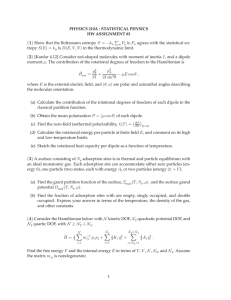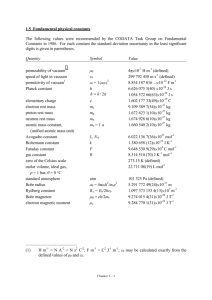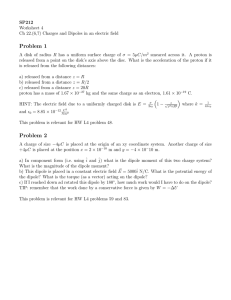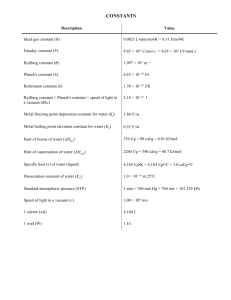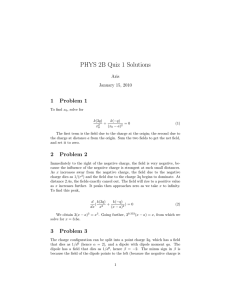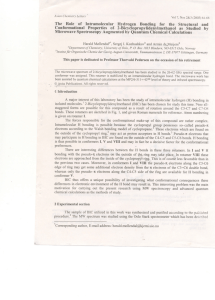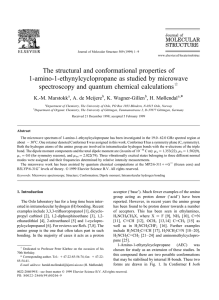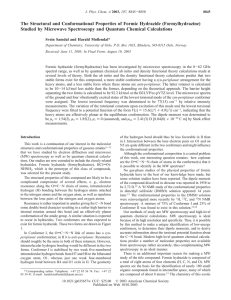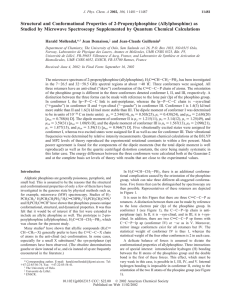Microwave spectrum, conformation and dipole moment of vinylditluorosilane
advertisement
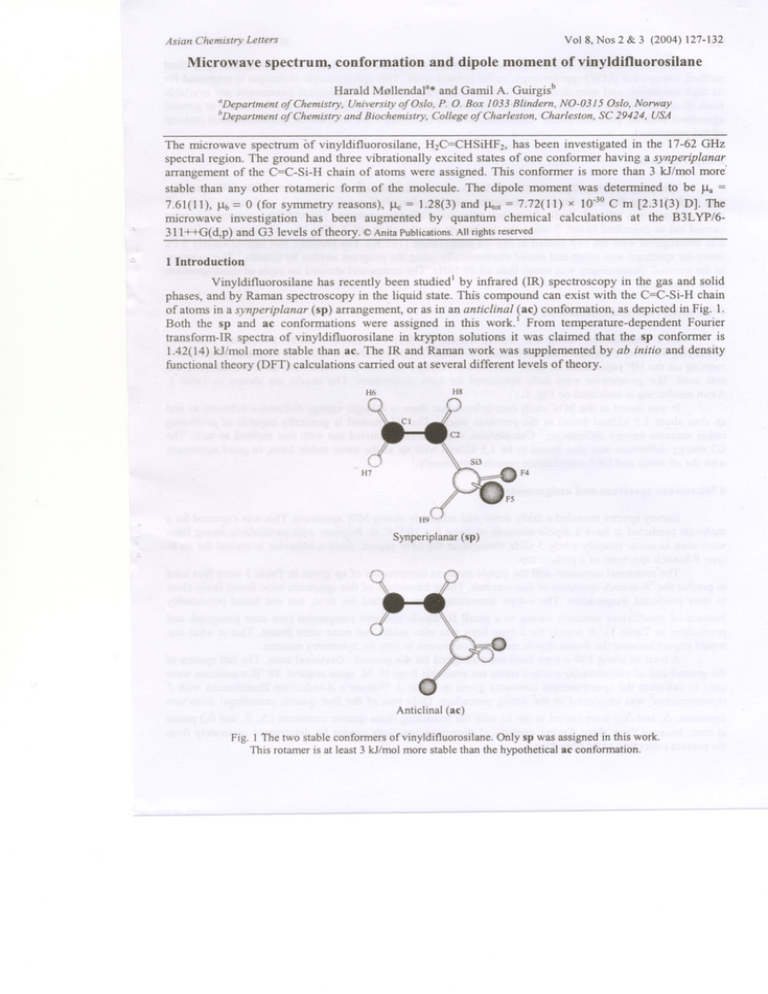
Asian Chemistry Letters Vol 8, Nos 2 & 3 (2004) 127-132 Microwave spectrum, conformation and dipole moment of vinylditluorosilane Harald Møllendala*and Gamil A. Guirgisb aDepartmentofChemistry,Universityof Oslo,P. O.Box 1033Blindern,NO-0315Oslo,Norway bDepartmentofChemistryandBiochemistry,CollegeofCharleston,Charlestan,SC29424,USA The microwave spectrum of vinyldifluorosilane, H2C=CHSiHF2,has been investigated in the 17-62 GHz spectral region. The ground and three vibrationally excited states of one conformer having a synperiplanar arrangement of the C=C-Si-H chain of atoms were assigned. This conformer is more than 3 kl/mol more' stable than any other rotameric fOrIn of the molecule. The dipole moment was determined to be Ila = 7.61(11), Ilb= O (for symmetry reasons), Ile = 1.28(3) and Iltot= 7.72(11) x 10-30C m [2.31(3) D). The microwave investigation has been augmented by quantum chemical calculations at the B3LYP/6- ~ 311 ++G( d,p) and G3 leve Is of theory. ieJAnita Publications. All rights reserved 1 Introduction Vinyldifluorosilane has recently been studiedl by infrared (IR) spectroscopy in the gas and solid phases, and by Raman spectroscopy in the liquid state. Tms compound can exist with the C=C-Si-H chain of atoms in a synperiplanar (sp) arrangement, or as in an antic/inal (ac) conforrnation, as depicted in Fig. l. Both the sp and ac conformations were assigned in this work.I From temperature-dependent Fourier transform-IR spectra of vinyldifluorosilane in krypton solutions it was claimed that the sp conformer is 1.42(14) kJ/mol more stable than ac. The IR and Raman work was supplemented by ab initio and density functional theory (DFT) calculations carried out at several different leveIs oftheory. H6 H8 F4 Synperiplanar (sp) ;;; Anticlinal (ac) Fig. I The two stable confonners ofvinyldifluorosilane. Only sp was assigned in this work. This rotamer is at least 3 kl/mol more stable than the hypothetical ac confonnation. 128 H Møt/enda/. G A Guirgis The structural and conformational properties of vinyldifluorosilane are investigated by a third method, microwave (MW) spectroscopy, in the present work. This spectroscopic technique is renowned for its high resolution and specificity, and is able to provide a number of physical parameters not available from JR or Raman spectroscopy. While the results obtained here regarding the sp conformer are in general agreement with the previous study,J discrepancies with that work were seen for the conformational makeup of this compound. 2 Experimental The preparation and purification of this compound has already been described.1 The MW spectrum was studied using the Oslo Stark spectrometer, which is described briefly in ref. 2. A 2 meter Stark cell made of brass was utilized. Radio frequency microwave double resonance (RFMWDR) experiments were carried out as described in ref. 3 using the equipment mentioned in ref. 4. The 17 - 62 GHz spectral range was investigated with the cell cooled to dry-ice temperature (195 K). The pressure was approximately 5 Pa when the spectrum was taken and stored electronically using the program written by Grønås.5The accuracy of the spectral measurement was better than :i:O.lO MHz. The compound showed no signs of decomposition in the brass cells. . 3 Quantum chemical calculations DFT' calculations using the hybrid functional B3LyP (Becke's three parameter functional employing the Lee, Yang and Parr correlation functional6)were carried out using the Gaussian 03 program? running on the HP superdome in Oslo. The 6-311++G(d,p) basis set provided with the Gaussian program was used. The geometries were fully optimized for both conformers. The results are shown in Table 1. Atom numbering is indicated on Fig. 1. It was found in the MW study (see below) that there is a larger energy difference between ac and sp than about 1.5 kl/mol found in the previous work.l The G3 method is generally capable of predicting rather accurate energy differences.8 Calculations were therefore carried out with this method as well. The G3 energy difference was also found to be 1.5 kl/mol with sp as the more stable form, in good agreement with the ab initio and DFT calculations reported previously.l 4 Microwave spectrum and assignments Survey spectra revealed a fairly dense and relatively strong MW spectrum. This was expected for a molecule predicted to have a dipole moment of about 9 x 10.30C m. Regions with particularly strong lines were seen to occur roughly every 5 GHz throughout the MW region. Such a behavior is typical for an atype R-branch spectrum ofa prolate top. The rotational constants and the dipole moment components of sp given in Table 1 were first used to predict the aR-branch spectrum ofthis rotamer. These transitions ofthis spectrum were found fairly dose to their predicted frequencies. The c-type transitions were searched for next, but not found presumably because of insufficient intensity owing to a small f..lcdipole moment component (see next paragraph and predictions in Table 1). A search for b-type lines was also made, but none were found. This is what one would expect because the b-axis dipole moment component is zero for syrnmetry reasons. A total of about 100 a-type lines were assigned for the ground vibrational state. The full spectra of the ground and ofvibrationally excited states are available from H. M. upon request. 89 aR-transitionswere used to calculate the spectroscopic constants given in Table 2. Watson's A-reduction Hamiltonian with r representation9 was employed in the fitting procedure. Only two of the five quartic centrifugal distortion constants, t:.Jand t:.JKwere varied in the fit with the rernaining three quartic constants (t:.k,bJ andbk) preset at zero, because these three further centrifugal distortion constants cannot be deterrnined accurately from the present collection ofaR transitions. , 129 Microwave spectrum. conformation and dipole moment ofvinyldifluorosilane Table 1. Optimized B3LYP/6-311++G** geometries, dipole moments and energy differences of the sp and ac conformers of vinyldifluorosilane sp conformer ac conformer Distances/pm C=C C-Si Si-F4 Si-F5 Si-H C-H6 C-H7 C-H8 133.7 184.3 161.8 161.8 147.2 108.6 108.7 108.8 133.7 184.4 161.9 161.9 147.2 108.6 108.6 108.9 Angles/deg. CCSi CSiH CSiF4 CSiF5 H6CC H7CC CCH8 1f1.5 113.4 110.4 110.4 122.2 122.1 118.9 123.1 116.2 108.6 110.0 121.9 121.9 118.7 180.0 0.0 0.0 180. 122.0 122.0 0.0 179.6 -0.2 0.7 179.9 -4.6 -121.6 117.2 6507.6 2734.9 2.169.1 6172.2 3030.4 2301.6 Dihedral angles/deg H6CCSi H6CCH8. H7CCSi H7CCH8 CCSiF4 CCSiF5 CCSiH Rotational constants/MHz A B C Dipole momentall 0.30C m a 3.33564 X 10,30 C m /la 9.59 /lb O.Ob /le 2.21 /ltot 9.84 7.42 2.48 4.02 8.80 = 1 Debye bFor symmetry reasons, sp has symmetry plane (Cs symmetry). Comparison of the experimental rotational constants (Table 2) with the B3LyP counterparts in Table 1 reveals about 3.3% difference for the A rotational constants, and 2.3 and 2.6 % difference for B and C rotational constants, respectively. The experimental rotational constants are alliarger than the theoretical --- 130 H Møllendal. G A Guirgis ones. The B3LYP values of /1J and /1JKare 0.46 and 12.7 kHz, respectively, compared to 0.284(12) and 16.918(26) kHz (Table 2). Table 2. Spectroscopic constants' of the ground vibrational state ofvinyldifluorosilane A/MHz B/MHz C/MHz /1jkHz /1JKlkHz No oftransitions: Rmsdev./MHz: 6735.28(14) 2796.8713(42) 2226.1977(41) 0.284(12) 16.918(26) 89 0.118 'A-reduction f-representation9 with two quartic centrifugal distortion constants (see text). The ground-state lines were accompanied by several lines of weaker intensity presumably belonging to vibrationally excited states. Three such excited states were assigned. Their spectroscopic constants are 1isted in Table 3. These states are assumed to be successively excited states of the torsion around the C-Si bond. This assignment has been made because the rotational constants change rather linearly upon excitation of this mode. An exponential decay of the intensities of the transitions belonging to successively excited states ofthis mode was also seen. Table 3. Spectroscopic constants' ofvibrationally excited states of the C-Si torsional vibration of vinyldifluorosilane Vibrational state: A/MHz B/MHz C/MHz /1JlkHz /1JKlkHz NO.oftransitions: RIns dev./MHz: 'Comments as for Table 2. 1st 2nd 3rd 6725.89(19) 2810.0179(58) 2226.9083(58) 0.314(17) 17.849(39) 6716.92 2823.3735(56) 2227.5172(54) 0.299( 15) 19.219(33) 6702.67(24) 2845.659(10) 2228.0596(74) 0.656(28) 24.061(51) 80 0.167 73 0.137 31 0.133 Relative intensity measurements were made to determine the vibrational frequency of the torsion around the C-Si bond following the procedure of Ref. 10. A value of 82(20) cm') was found compared to 70 cm'l found in the JR work.I The present B3LYP calculations yield 77 cm'l for this mode. 5 Dipole moment The dipole moment of the sp conformer was determined in a least-squares tit using the second-order Stark coefficients shown in Table 4. The weight of each Stark coefficient was taken to be the inverse squares of 131 Microwave spectrum. conformation and dipo/e moment of viny/difluorosi/ane the standard deviation of that coefficient. The cell was calibrated using OCS, whose dipole moment was taken to be 2.3857(68) x 10.30C m.u P-bwas preset to zero in the least squares tit owing to the symmetry of this rotamer. Comparison of the experimental result (Table 4) with the B3LYP dipole moment shown in TableI shows that the theoretical dipole moment is found to be too large by about 8 %. This is typical. Table 4. Stark coefficients and dipole moment ofvinyldifluorsilane Transition ~v/E2/(MHz Obs.-calc. Observed 50.5 40,4 51.5 41.4 61.6 51,5 Dipole moment/(IO.3O C m): /la = 7.61(11) IMI= 1 IMI=2 IMI=3 IMI=O IMI=2 IMI=2 IMI=3 IMI=4 -IU2( 13) -2.54(4) 11.24(15) -10.91(13) 19.02(22) 7.67(10) 25.3(3) 46.8(6) /lb = Ob /le = 1.284(28) V.2 cm2)10.7 0.19 0.005 -0.67 -1.30 -0.06 0.28 1.32 -0.32 /l10(= 7.72(11) [2.31(3) D] 'Uncertainties represent one standard deviation. bThis dipole moment component is zero for symmetry reasons. 6 Searches for the ac conformer The previous study,l as well as the quantum chemical calculations, incticate that there should be a small energy difference of a few kJ/mol between ac and sp, with the latter compound as the more stable form. The ac rotamer has a statistical weight of 2 compared to sp. The /la dipole moment component is predicted (Table 1 and ref. l) to be the largest one for each conformer. They are also calculated to be rather similar (Table 1). A small energy difference between ac and sp should thus lead to a comparatively strong "R- spectrum belonging to ac. The assignments reported above include all the strongest MW lines found in this spectrum. However, a number of weaker lines remained unassigned, and it was decided to search for the alleged ac conformer among them. Extensive Stark and RFMWDR searches were carried out. The rotational constants and /l" given in Table 1 were used to predict the spectrumof the hypotheticalac rotamer.However,no assignments could be made. It is conc1udedthat the energy difference between the two forms must detinitely be larger than 1.5 kJ/mol, if ac indeed exists as a high-energy form of the tide compound. Our conservative estimate is that the energydifferenceis largerthan 3 kJ/mol. The discrepancy between the present result (more than 3 kJ/mol) and the previous experimental study considering the energy difference between the two formsl (1.42(14) kJ/mol) is not easy to explain. Durig et all deterrnined the energy difference in krypton solution, whereas the present study was carried but in the gas phase. It is possible that this difference is important. A correct' quantum mechanical modeling of the energy difference between the two forms is certainly demanding since vinyldifluorosilane contains the two highly electronegative fluorine atoms in ------ 132 H Mol/enda/, G A Guirgis addition to the silicon atom. This complexity may explain why G3 as well as the other quantum chemical calculations fail to produce a correct energy difference. 7 Conclusions This MW study confmns the previous experimental finding and quantum chemical predictions that vinyldifluorosilane prefers the sp conforrnation. The energy difference between this and the ac form is considerably higher than previously thought, amounting to more than 3 kl/mol. Aeknowledgements. Anne Horn is than1redfor her assistance. Cand. scient Terje Grønås is thanked for his computer program that sweeps the MW synthesizer and collects the resulting spectra. This work has received support from The Research Cou!lcil of Norway (Program for Supercomputing) through a grant of computer time. References l. 2. 3. 4. 5. 6. 7. Durig J R, Guirgis G A, Zheng, C, Mohamed T A, Speetroehim. Acta 59A (2003) 2099. Guirgis G A, Marstokk K-M, Møllendal H, Acta Chem. Scand., 45 (1991) 482. Wodarczyk F J, Wilson E B Jr., J. Mol. Speetrose. 37 (1971) 445. Marstokk K-M, Møllendal H, Acta Chem. Scand., A42 (1988) 374. Grønås T, Personal communication 2003. Becke A D, J. Chem. Phys., 98 (1993) 5648. Frisch M J, Trucks G W, Schlegel H B, Scuseria G E, Robb M A, Cheeseman J R, Montgomery J A Jr, Vreven T, Kudin K N, Burant J C, Millam J M, Iyengar S S, Tornasi J, Barone V, Mennucci B, Cossi M, Scalrnani G, Rega N, Petersson G A, Nakatsuji H, Hada M, Ehara M, Toyota K, Fukuda R, Hasegawa J, Ishida M, Nakajirna T, Honda Y, Kitao O, Nakai H, Klene M, Li X, Knox J E, Hratchian H P, Cross J B, Adamo C, Jaramillo J, Gomperts R, Stratmann R E, Yazyev O, Austin A J, Cammi R, Pomelli C, Ochterski J W, Ayala P Y, Morokurna K, Voth G A, Salvador P, Dannenberg J J, Zakrzewski V G, Dapprich S, Daniels A D, Strain M C, Farkas O, Malick D K, Rabuck A D, Raghavachari K, Foresman J B, Ortiz J V, Cui Q, Baboul A G, Clifford S, Cioslowski J, Stefanov B B, Liu G, Liashenko A, Piskorz P, Kornaromi I, Martin R L, Fox D J, Keith T, AI-Laham M A, Peng C Y, Nanayakkara A, Challacoinbe M, Gill P M W, Johnson B, Chen W, Wong M W, Gonzalez C, Pople J A, Gaussian 03, Revision B.03; Gaussian, Inc., Pittsburgh PA, 2003. 8. Curtiss L A, Raghavachari K, Redfem P C, Rassolov V, Pople J A, J. Chem. Phys., 109 (1998) 7764. 9. Watson J K G, Vibrational Speetra and Structure; Elsevier: Amsterdam, 1977, Vol. 6. 10. Esbitt A S, Wilson E B, Rev. Sei. Jnstrum., 34 (1963) 901. Il. Muenter J S, J. Chem. Phys.,48 (1968) 4544. [received 28.05.04, accepted 09.08.04]

